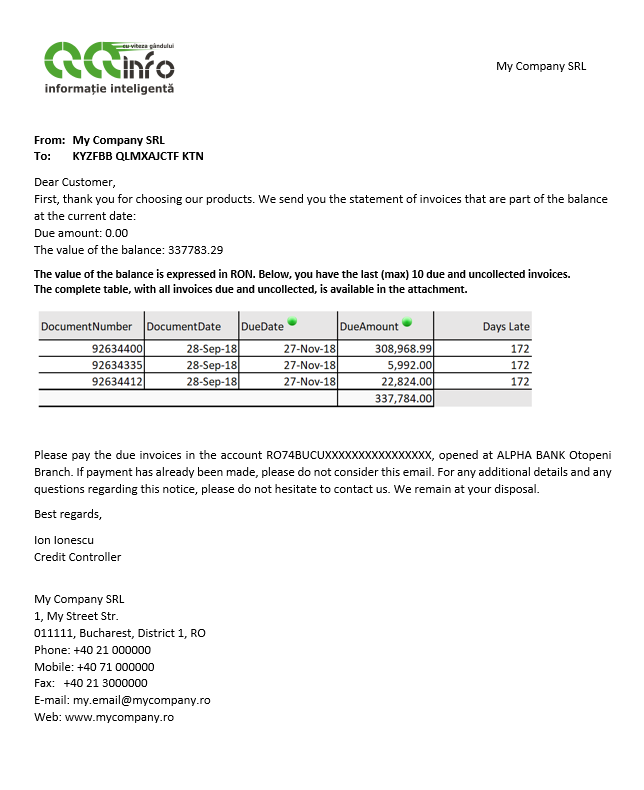
The monitoring of uncollected and unpaid balances, as well as that of receipts and payments are closely linked and constitute the starting point for direct cash flow projections (bottom-up), but also for working capital and cash collection cycle analyzes.
To be able to respond promptly and effectively to the request “show me the money!” , the finance department has to balance 3 essential components in the construction of the so-called free cash flow:
- Current cash balance (cash and in the bank)
- Accounts Receivable
- Accounts Payable
But these balances are in constant moving, being changed:
- by the invoices issued and received,
- as well as by the payments made and receipts received.
In QQsip™ you can also access comparative visual analytics of simultaneous evolution of the balances (customers/ suppliers/ cash) of the beginning, turnover, and final.
OBS: It is worth noting, moreover, that all the above views are part of the possible extracts available from a single ultra-dynamic object, in which the user can decide, on the spot, in the interface, which is the most appropriate view. In the example below, the user decides if he wants to see all 3 monthly phases of the total on FreeCash, or only the turnover and the final, or only the turnover, or the initial values and the turnover.




There and when the user deems it necessary, the views can simultaneously bring balances, but also the breakdown of component turnovers, as in the examples below.
Late Balances
Late balances from customers can often be combined with late balances with suppliers and current cash balances.
Among current receivables not receivable, an essential subset to be managed is that of overruns (especially on receipts), a context in which, along with the analyzed monetary value, the maturity term is also of maximum importance.
Trade relations with many entities will bring a series of challenges in capturing simultaneously in synthetic and analytical views everything that is relevant in terms of general, current and exceeded balances, especially when the dispersion of results is large. QQsip™ proposes a set of highly performing and intuitive analytics to quickly identify trends and exceptions in overdue balances.
Late Interval Analytics
Analiytics can be done:
- on current balances
- on balances at an earlier date
- on all receipts to date
- on all receipts in a timeline
- on all receipts from a defined interval of a start date and an end date
Letters of notification of late payment (or summons)
Where there are no other solutions with this role, we can implement in QQsip™ an engine that generates automatically (or semi-automatically), alert letters and/ or notification to bad payers. Here is an example, in which the template texts were defined only once, and the entire letter is generated (and possibly sent to the appropriate email addresses) automatically or semi-automatically.

Dual Partner Balances
Relationships with dual partners, with the role of customers and suppliers simultaneously, determine the need for special analysis of the balances of these partners, needs that we have already addressed in QQsip™.
And if we want to highlight the history of these balances, we can choose how much history we need.
(but it is not necessary to have the entire history included in the selection from the beginning so as not to alter the intermediate balances!)
Remarks:
QQsip™ provides information on current and overdue balances, both of customers and suppliers, both at the present time and at any previous historical date in the time horizon in which we have data on invoices issued and received together with settlements related to them.
All information presented here graphically is available in the interface and for export and in tabular formats.
In the example below, the system allows you to choose a start time and a final time, and here are provided synthetically the evolutions of the balances.
Negative customer balances are cash received in advance and are therefore marked in green.
Instead, for the warning coloring of the percentages of variation, you can choose 2 range ends for good = green, the rest being signaled with 1 or 2 alert colors:
When desired, the turnover and balance at the level of documents can be broken down, both on the entire list of documents issued in the interval, but also with the option to show only the documents left with the balance at the end of the period.
Final remark:
The information collected by QQsip™ is the starting point for QQcashflow™ analytics .
For QQinfo solutions, please visit this page: QQsolutions.
For information about Qlik™, please access this site: qlik.com.
If you are interested in QQsip™ product, or you need more information, please fill in the form here .
To be in touch with the latest news in the field, unique solutions explained, but also with our personal perspectives regarding the world of management, data, and analytics, we recommend the QQblog !